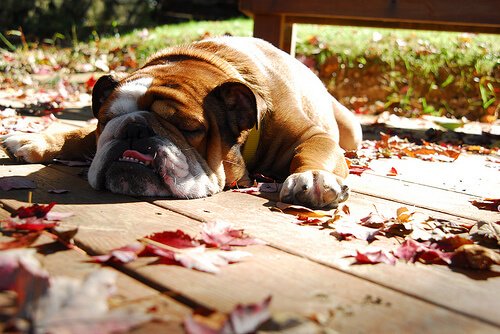How to Treat Nasal Congestion in Dogs

Have you ever heard your dog sneezing, having a runny nose, or even snoring? These are all indicators that your dog may be congested. Nasal congestion in dogs does not always cause a cold. However, it’s annoying for the animal and could be caused by a respiratory infection that needs to be treated.
If you notice these symptoms in your dog, you need to take him to the veterinarian as soon as possible. However, while the prescription medication is taking effect, you can do several things at home to help treat him.
Nasal Congestion in Dogs
Nasal congestion in dogs is a clear sign that the animal has a cold, even thought it could be caused by other reasons, such as a respiratory infection or an allergy. It could also take place due to the animal having something in his nose that you have not noticed.
A dental infection spreading to the nasal area can cause nasal congestion in dogs. That’s why the most advisable thing to do is to take your dog to the vet, so the doctor can explain to you what is happening and determine the cause.
Normally sinusitis — also known as nasal congestion — is not serious. As you may know by now, you cannot be too careful about things that affect your pet’s health. When possible, try your best to prevent your dog from getting sick.

The symptoms of nasal congestion in dogs are usually sneezing, coughing, snoring, and/or sudden breathing. Plus, nasally congested dogs can get very runny nose and start breathing through their mouth
A trusted vet needs is the one in charge of figuring out the cause of your dog’s condition and tell you how to treat it. However, there are a few things you can do at home to treat nasal congestion in dogs right away.
How to Treat Nasal Congestion in Dogs at Home
Depending on the condition, the vet could prescribe your pet antihistamines, steroids, topical creams, or in the worst of cases, antibiotics, in order to treat infections. While these medications take effect, your dog will continue being congested. This is very annoying to the animal and probably will not allow him to sleep.
Here are some tips about treating your dog’s nasal congestion at home:
Massage Your Dog’s Nose
Sometimes, congestion can be caused by a nasal irritation that swells the nose area. Lightly massaging the upper part of your dog’s nose helps alleviate the swelling and allows him to breathe better.
Give Your Dog a Bowl of Warm Food
The heat from the food can help unclog your dog’s nostrils and relieve his congestion. For example, you could make him soup containing healthy and suitable ingredients for dogs, or you can also heat up some wet food. Even if this remedy does not work on your dog, he is bound to enjoy the delicious meal.
Feed Your Dog an Appetizing Diet
Similarly to humans, when an animal feels ill for any reason (in this case, due to nasal congestion) it is possible that it may lose its appetite. This will inevitably cause the animal’s immune system to weaken, which makes it easier to contract a disease.
If your dog’s nasal condition is cause by a congestion then his loss of appetite will cause the infection to advance more quickly.

One of the best ways to alleviate nasal congestion in dogs is by feeding the animal a reinforced diet that will strengthen his immune system.
Wipe Your Dog’s Nose
Sometimes, the accumulation of liquid that an animal’s nose expels when there is congestion can be the cause of the congestion itself.
That’s why we recommend that you, very gently and carefully, try to dry some of the water in the animal’s nose by using cotton swabs. This can help the respiratory system to open up a little bit.
Use Steam
This will probably be a somewhat more difficult remedy to apply because your dog may not like it. However, it’s the most effective. The steam will help open the animal’s nostrils and allow him to breathe properly.
Remember to follow these tips, and make sure to ask your vet to prescribe a nasal spray that you can use on the animal. If you stick to these methods, you should be able to drastically relieve nasal congestion in dogs.
All cited sources were thoroughly reviewed by our team to ensure their quality, reliability, currency, and validity. The bibliography of this article was considered reliable and of academic or scientific accuracy.
- Windsor, R. C., & Johnson, L. R. (2006). Canine chronic inflammatory rhinitis. Clinical techniques in small animal practice, 21(2), 76-81.
- Windsor, R. C., Johnson, L. R., Herrgesell, E. J., & De Cock, H. E. (2004). Idiopathic lymphoplasmacytic rhinitis in dogs: 37 cases (1997–2002). Journal of the American Veterinary Medical Association, 224(12), 1952-1953.
- Hawkins, E. C., Johnson, L. R., Guptill, L., Marr, H. S., Breitschwerdt, E. B., & Birkenheuer, A. J. (2008). Failure to identify an association between serologic or molecular evidence of Bartonella infection and idiopathic rhinitis in dogs. Journal of the American Veterinary Medical Association, 233(4), 597-599.
This text is provided for informational purposes only and does not replace consultation with a professional. If in doubt, consult your specialist.